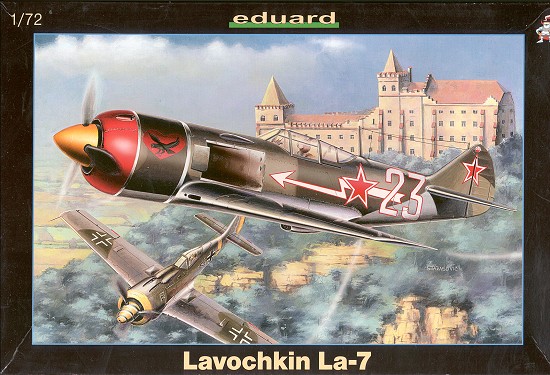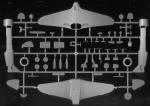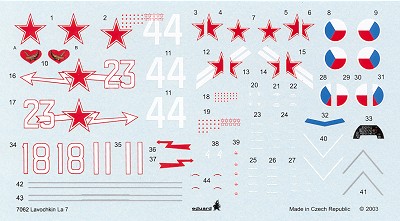
| KIT: | Eduard 1/72 Lavochkin La-7 |
| KIT #: | 7062 |
| PRICE: | $14.98 MSRP |
| DECALS: | Four options |
| REVIEWER: | Scott Van Aken |
| NOTES: | Includes canopy, wheel and markings masks |

| HISTORY |
Developed from the highly successful La-5, the La-7 was quite similar in general appearance to the earlier fighter, using many of the same airframe components. The big difference was in engine and armament. A new 1850 hp Shvetsov radial engine and increase in armament to three nose mounted cannon made for a very potent aircraft. In tests, the La-7 was nearly 45 mph faster than its major opponent, the FW-190.
First flying in early 1944, the La-7 was quickly deployed to the VVS's finest fighter regiments, where many of the Soviet Union's aces praised the aircraft for its increased speed, maneuverability and firepower over the slightly slower La-5. In order to improve performance even more, most La-7s returned to having only two cannon. Besides, by that time in the war, the presence of the Luftwaffe was being felt even less and less. Of the approximately 3300 La-7s produced the vast majority of the production run was of the two cannon variety.
The end of the war and the coming of gas turbine engines for fighters meant that the La-7 had a relatively short active service. The Soviet Union had purged them from all fighter regiments by 1947, having replaced them with La-9/11 aircraft or with the earliest Soviet jets. In those countries under Soviet influence or control, the aircraft lasted into the early 1950s.
| THE KIT |
 I
have to confess to you all that I've not kept track of Eduard's 1/72 kits
as much as those from other companies. Besides, Italeri and KP have both
had pretty nice La-7s in this scale and face it, most Soviet planes of this
period were a bit dull. Basically greys and numbers. Yeah, not a totally
accurate look at things, but there you have it.
I
have to confess to you all that I've not kept track of Eduard's 1/72 kits
as much as those from other companies. Besides, Italeri and KP have both
had pretty nice La-7s in this scale and face it, most Soviet planes of this
period were a bit dull. Basically greys and numbers. Yeah, not a totally
accurate look at things, but there you have it.
Well, this year, Eduard has produced a new La-7 kit (at least the instructions are dated 2004). In the box, you fine one large sprue, a clear sprue (not shown) and a set of canopy and wheel masks (also not shown). The parts themselves are all that one has come to expect from Eduard. The detailing is superb, they are totally free of flash, sink areas or ejector pin marks that will show. They are right up there with the big boys from what I can see in the box.
As you might expect from a fighter, there are no real options aside from the choice of an open or closed canopy. A nice touch is that the wheel hubs are separate so that you can paint the tires without worrying about slopping paint onto the hubs. Not used are the nose and upper cowling for the three cannon fighter as this is the most produced two gun version. However, it is nice to know it is there in case one wanted to do some research and produce an early La-7 model.
 Instructions
are really superb with clearly done construction steps and color callouts
for all the parts. Paint references are for Gunze, Tamiya, Humbrol, Revell,
and Testors. In addition, Soviet AMT color information is provided for the
overall airframe. La-7s were nearly all done in AMT 11/12 uppers with AMT 7
undersides. I should point out that these are greys. Why the box art plane
is in what seems to be browns is beyond me. There are markings for four
aircraft given in the kit. White 23, the box art airplane, is for PY
Golovachev of the 9 GIAP, White 44 is the 482nd IAPs VI Koroljov, and White
18 is for AS Kumanichkin of the 176 GIAP. All thee planes have red forward
cowlings while White 18 has a white tail section and a red triangle aft of
the cowling. The fourth aircraft is a Czech version of the 2nd
Fighter Regiment in post-war 1945. There is a mask for the triangle on
White 18 so no worries about getting that right. The decal sheet is very
well printed and quite comprehensive in terms of data stencils. My previous
experience with Eduard decals has been quite positive so these should work
quite well.
Instructions
are really superb with clearly done construction steps and color callouts
for all the parts. Paint references are for Gunze, Tamiya, Humbrol, Revell,
and Testors. In addition, Soviet AMT color information is provided for the
overall airframe. La-7s were nearly all done in AMT 11/12 uppers with AMT 7
undersides. I should point out that these are greys. Why the box art plane
is in what seems to be browns is beyond me. There are markings for four
aircraft given in the kit. White 23, the box art airplane, is for PY
Golovachev of the 9 GIAP, White 44 is the 482nd IAPs VI Koroljov, and White
18 is for AS Kumanichkin of the 176 GIAP. All thee planes have red forward
cowlings while White 18 has a white tail section and a red triangle aft of
the cowling. The fourth aircraft is a Czech version of the 2nd
Fighter Regiment in post-war 1945. There is a mask for the triangle on
White 18 so no worries about getting that right. The decal sheet is very
well printed and quite comprehensive in terms of data stencils. My previous
experience with Eduard decals has been quite positive so these should work
quite well.
| CONCLUSIONS |
Overall, I'd have to say that this is a vastly superior kit to those previously produced by KP and Italeri. Not being a very complex aircraft, it should build rather quickly and provide satisfying results. Those who may blanche at forking over $15 for a WWII single engine fighter have to just face the reality that this is what the market now commands for kits like this so Eduard isn't breaking any new ground here.
If you would like your product reviewed fairly and quickly by a site that has nearly 300,000 visitors a month, please contact me or see other details in the Note to Contributors.